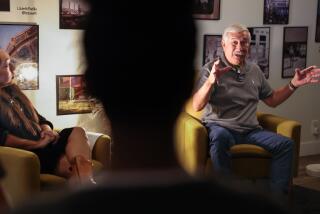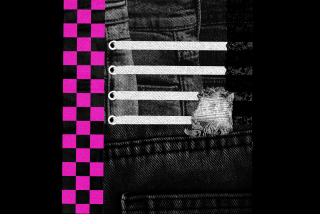Confronting Hate Crime
LAKE FOREST — The crudely painted symbols of hate were waiting for Gina Lamourelle when she arrived at her day-care center in November. For several long moments, the 42-year-old black woman stared at the black swastikas and “KKK” initials scrawled on the white stucco walls outside the nursery school.
Within an hour, the graffiti were painted over. Not so easily erased were long-buried memories of the racism she experienced while growing up in the small coal-mining town of Gary, W.Va.
“In my mind I could see the writing on the bathroom doors, ‘coloreds’ and ‘whites,’ ” Lamourelle said, recalling images of herself as a 10-year-old going to a segregated theater. “(The ‘coloreds’ door) was dirty, with fingerprints smeared over it.
“I hadn’t thought of (this) for over 30 years. I guess it took a crisis to bring those memories to the surface.”
Rather than remain anonymous, as do many victims of hate crimes, Lamourelle has chosen to speak out about racism in Orange County, where she has lived for 16 years. Lamourelle has written newspaper articles, held a press conference to report the incident and participated in a recent forum on race relations at Saddleback College.
“Whether I like it or not, I’ve become a symbol for some people in the community,” she said. “There’s a problem in the country and the county that needs to be addressed.”
In 1991, more than 120 hate-related incidents were reported to the Orange County Sheriff’s Department and the county Human Relations Commission.
In late November, vandals hit Trabuco Hills High School, covering the school with racist slogans such as “Thank God I’m White.”
At Saddleback College in December, three employees and a former employee who said he quit because of racial harassment told of threatening anonymous phone calls and racial slurs received through interoffice mail.
On Friday, vandals defaced the Brookhurst Baptist Church in Fullerton with swastikas and satanic symbols.
“It’s definitely my impression that there’s an increase on hate-related activity,” said Rusty Kennedy, director of the county Human Relations Commission. “Economic times are difficult and people are feeling threatened. We’ve got all the ingredients we need to create conflicts and I’m afraid that’s what we’re in for.”
Along with the racial trouble, however, has come public intolerance for such actions.
Last summer, Mission Viejo city officials formed an anti-hate crime task force to examine the problem. In November, Lake Forest business and civic leaders rallied around Lamourelle at a press conference to express the community’s disgust over the racist graffiti that marred the Saddleback Children’s Discovery Center.
Since then, Lamourelle has “really been overwhelmed by the number of people who have felt it necessary to say something.”
Among this group is Bob Lay, chairman of the South Orange County Chamber of Commerce, who called the graffiti “extremely reprehensible. We’re not going to put up with this in Lake Forest. It’s not just bad for business, it’s bad for everyone.”
Lay added that Lamourelle was “about the worst person those vandals could have chosen to pick on. Gina is dynamic, aggressive and a good businesswoman. She has never allowed any of stereotypical constraints--being female and being black--to hold her back.”
Racial lines were clearly drawn when she was growing up in West Virginia, Lamourelle said.
“Most of the white families lived up in the hills and ‘the coloreds,’ as black people were referred to back then, lived down in what we called ‘the bottoms,’ ” she said. “When it came time to go to church, school or the hospital, it was all segregated.”
When Lamourelle was 7, her older sister died.
A year later, she was suffering from a kidney infection and her parents took her to the hospital. “I recall being wheeled past the pediatrics ward,” she said.
Lamourelle was placed in a ward filled with “old, dying colored people.” The man in a bed near her died, then an elderly woman.
“I thought I was next in line,” she said.
When her mother explained that it was a ward for black people of all ages and conditions and that she was not going to die, Lamourelle was relieved. “I said, ‘Oh, that’s why, (I’m in this ward) just because I’m colored.’ That was something familiar that I could deal with.”
At age 13, her family moved to the San Fernando Valley. She attended UC Santa Barbara during the height of the black power movement in the late ‘60s, and remembers standing up to the president of the black students union when he confronted her about dating white men.
She lived in Europe for three years after graduation, and married Alain Lamourelle, a tall, dark-haired Frenchman. They lived in Germany, then moved to Mission Viejo in 1975.
Last year, Lamourelle said, “my 9-year-old came home after school and she was really upset because someone told her that she was half as good as her classmates. Just because her dad was white and her mom was black. She was angry and she asked me, ‘Mom, is that true?’ ”
“I realized just what a limited view of the world I was even giving my own children,” Lamourelle said. “I felt my children should know more about that side of their heritage so they can feel good about themselves and know that they’re not ‘half as good.’ ”
Lamourelle foraged through local libraries, researching history to gather information about the contributions of blacks in America.
When she shared what she had learned with her daughter, her daughter told her, “Mom, I’m mad. They’ve been lying to me (in school). There are black people doing good things. They’ve been hiding that from me.”
Lamourelle said, “From what is taught in schools, I can see where a white child can feel that it’s better to be white. And I can see where a black child can feel that it’s not too good to be the color I am.”
The problem locally, she said, is that schools do not see the need to blend information about other races into their curriculum other than on special days, such as Cinco de Mayo and Martin Luther King Day. Experts on race relations in the county agree.
“Schools need to move away from having a tourist-type approach in ethnic education,” said Kennedy of the Human Relations Commission. “If you want to understand the Lopezes and the Hernandezes, just celebrating Cinco de Mayo isn’t going a long way.”
This summer--for the first time since 1966--Lamourelle plans to visit her hometown, traveling from her house on the hills of Mission Viejo to “the bottoms” of Gary.
“I’m excited and I’m frightened in a way too,” she said. “I don’t know what I’ll find. My kids want to know where I grew up, so we’re going back.
“It’s like coming full circle. Living there was kind of like a dream. I guess this will make the dream more real.”
More to Read
Sign up for Essential California
The most important California stories and recommendations in your inbox every morning.
You may occasionally receive promotional content from the Los Angeles Times.










